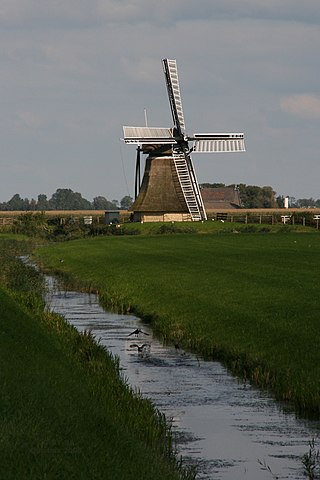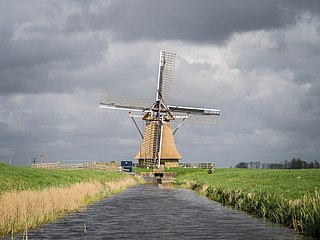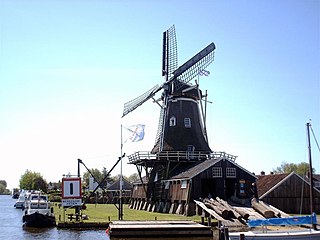
De Achlumer Molen is a smock mill in Achlum, Friesland, Netherlands which has been restored to working order. The mill is listed as a Rijksmonument, number 15821.

De Oudkerkermolen, or Oudkerkemolen is a smock mill in Aldtsjerk, Friesland, Netherlands which has been restored to working order. The mill is listed as a Rijksmonument, number 35674.

De Zwaluw is a smock mill in Burdaard, Friesland, Netherlands which is working commercially. The mill is listed as a Rijksmonument, number 15585.

Aylvapoldermolen is a smock mill in Burgwerd, Friesland, Netherlands which has been restored to working order. The mill is listed as a Rijksmonument, number 15626.

De Vlijt, formerly known as Hoop van Zegen is a smock mill in Zuidwolde, Drenthe, which has been conserved. The mill was built in 1878 and is listed as a Rijksmonument, number 41099.

Kingmatille is a smock mill in Dronryp, Friesland, Netherlands which was moved to its present location in 1985. The mill is listed as a Rijksmonument, number 28614. The windmill is named after the nearby hamlet of Kingmatille.

De Hatsumermolen is a smock mill in Dronryp, Friesland, Netherlands which was built in 1878. The mill is listed as a Rijksmonument, number 28615.

De Gans is a smock mill in Ezumazijl, Friesland, Netherlands which has been restored to working order. The mill is listed as a Rijksmonument, number 31571.

Arkens is a Hollow Post mill in Franeker, Friesland, Netherlands which has been restored to working order. The mill is listed as a Rijksmonument, number 15710. It shares its name with the eponymous hamlet, just north of Franeker, Arkens.

De Modderige Bol is a Hollow Post mill in Goëngahuizen, Friesland, Netherlands which has been restored to working order. The mill is listed as a Rijksmonument, number 34001.

De Hantumermolen is a smock mill in Hantum, Friesland, Netherlands which was built in 1880. The mill has been restored to working order. It is listed as a Rijksmonument, number 38619.

Tochmaland is a smock mill in Kollum, Friesland, Netherlands, which was built in 1893. The mill has been restored to working order. It is listed as a Rijksmonument, number 23743.

De Sweachmermolen is a smock mill between Langweer and Boornzwaag, Friesland, Netherlands which was built in 1782. The mill has two functions: it is a drainage mill and a corn mill. It has been restored to working order as a drainage mill and is listed as a Rijksmonument, number 13241.

Froskepôlemolen is a smock mill in Leeuwarden, Friesland, Netherlands which dates from 1896 but was rebuilt on its present site in 1962. The mill has been restored to working order and is listed as a Rijksmonument, number 24507.

De Bullemolen English: The Executioner's Mill is a smock mill in Lekkum, Friesland, Netherlands which was built in 1825. The mill has been restored to working order and is listed as a Rijksmonument, number 24505.

De Weyert is a smock mill in Makkinga, Friesland, Netherlands which was built in 1925 and is in working order. The mill is listed as a Rijksmonument, number 31725.

The Klaarkampstermeermolen or Klaarkampstermolen is a polder windmill in Rinsumageast, Friesland, the Netherlands. Built in 1862 the smock mill was relocated to its current position in 1893 and has been restored several times. Worked by volunteers it still drains the Klaarkampstermeer as of 2022. The mill is listed as a Rijksmonument since 1970 and can be visited by appointment.

De Skarrenmolen is a smock mill in Scharsterbrug, Friesland, Netherlands which was built in 1888. The mill has been restored to working order. It is listed as a Rijksmonument.

Ybema's molen is a smock mill in Workum, Friesland, Netherlands. It has been restored to working order. Designated as being held in reserve, it is listed as a Rijksmonument.

De Jager is a smock mill in Woudsend, Friesland, Netherlands which was built in 1719 and is in working order. The mill is listed as a Rijksmonument.





















